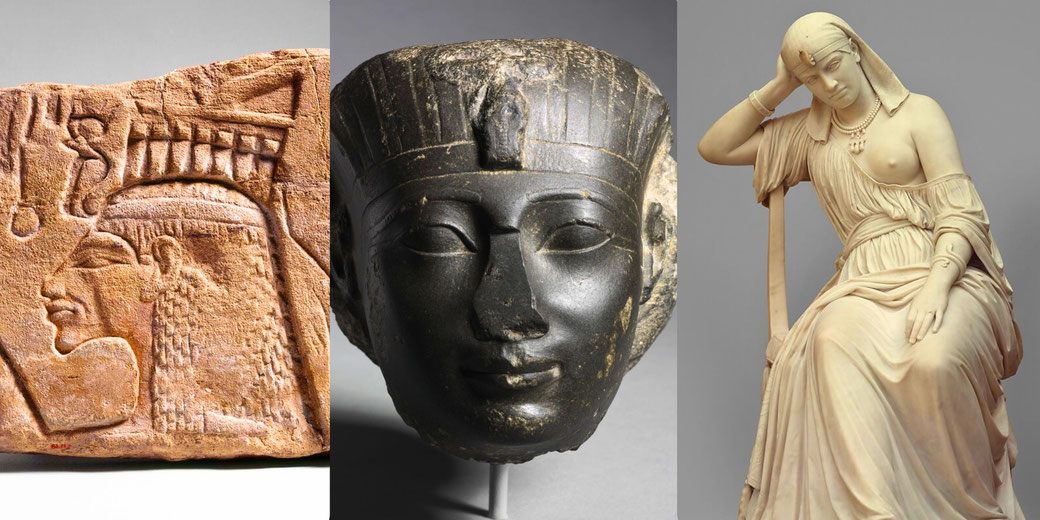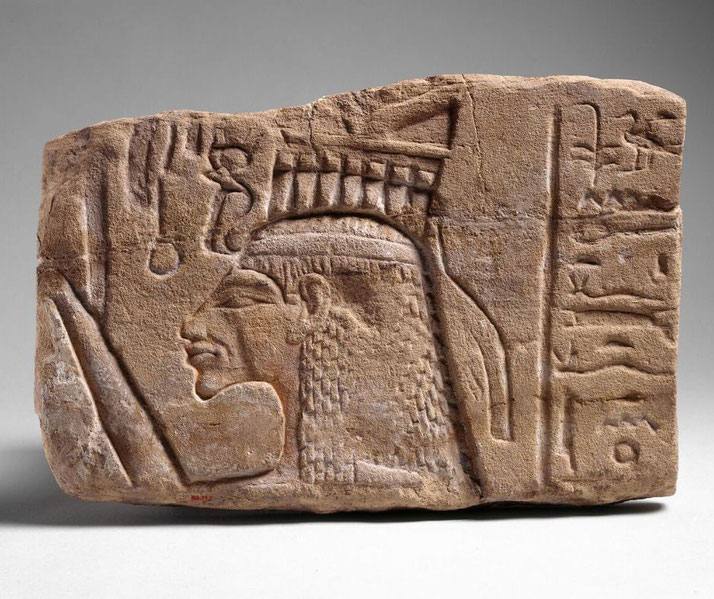The 3 greatest ancient Egyptian queens

When studying Ancient Egypt, most people tend to focus on the powerful men who ruled the country as pharaohs.
However, three extraordinary women also ruled the Nile Valley, wielding power and influence in an era where men predominantly held the reins of leadership.
Nefertiti, Hatshepsut, and Cleopatra – these names reverberate through the corridors of history, etched indelibly into the annals of one of the world's earliest and most influential civilizations.
Each queen was unique, each ruled in a different epoch with contrasting societal and political landscapes, yet all left indelible marks on ancient Egypt and the world.
How did these women ascend to the throne in a largely patriarchal society?
What tools and strategies did they use to maintain their power?
And how did they influence the culture, politics, and society of their time, and what legacy have they left for future generations?
1. Nefertiti
Born around 1370 BC, Nefertiti was of noble lineage but not of royal blood. Her parentage remains a mystery, adding to her allure and enigma.
Some scholars speculate that she was a princess from a neighboring kingdom; others suggest she may have been the daughter of the powerful courtier Ay.
At a young age, she married the future Pharaoh Akhenaten, then known as Amenhotep IV, and together they would embark on a transformative reign.
As queen, Nefertiti played a pivotal role in one of the most controversial periods of Ancient Egyptian history.
Together with Akhenaten, she revolutionized Egypt's religious landscape, shifting it from a polytheistic system to a monotheistic one focused on the sun god Aten.
The royal couple even moved the capital to a new city, Akhetaten (today known as Amarna), to symbolize their devotion to Aten.
Queen Nefertiti's reign saw a radical transformation in Egyptian art and culture. The stiff, formal style of Egyptian art was replaced by more natural, realistic portrayals.
The queen herself is immortalized in the famed bust discovered by a German archaeological team in 1912.
This iconic piece of artistry, showcasing her grace and beauty, is regarded as one of the greatest masterpieces of ancient Egyptian art.

Around the 14th year of Akhenaten’s reign, Nefertiti vanished from historical records.
This abrupt disappearance has been the subject of many theories and debates among historians.
Some suggest she fell out of favor and was banished, while others theorize that she may have assumed a new identity and ruled as a pharaoh under the name Neferneferuaten.
Despite the mysteries surrounding her life and death, Queen Nefertiti's impact on ancient Egypt is undeniable.
Her role in religious reform, coupled with her powerful presence in art and culture, have made her one of the most recognized figures in ancient Egyptian history.
Her name, meaning "a beautiful woman has come," continues to be as evocative today as it was over three thousand years ago.
2. Hatshepsut
Queen Hatshepsut, born around 1507 BC, was the daughter of Pharaoh Thutmose I and his wife, Queen Ahmose.
As the only surviving child, Hatshepsut had a unique upbringing. While her half-brother, Thutmose II, would inherit the throne, Hatshepsut was groomed for rule as the Great Royal Wife, a position that held considerable influence and power.
When Thutmose II died prematurely, the throne fell to his son by a lesser wife,
Thutmose III, who was still a child at the time. Initially, Hatshepsut acted as regent on her stepson's behalf, but in a bold and unprecedented move, she declared herself pharaoh around seven years into his reign.
She assumed all the regalia and titles of a king, even adopting a false beard—a symbol of pharaonic power.

Hatshepsut's reign was marked by peace, prosperity, and significant architectural achievements.
Her most notable accomplishment was the construction of the Mortuary Temple at Deir el-Bahri, an architectural marvel that stands as a testament to her ambition and vision.
Under her rule, Egypt also conducted an impressive trading expedition to the distant land of Punt, bringing back valuable commodities and exotic goods.
Hatshepsut's rise to power was not without controversy. After her death, Thutmose III, her stepson and co-ruler, ordered a systematic erasure of her inscriptions and images from monuments and temples.
Whether this was an act of vengeance or a practical move to ensure his son's smooth succession is still a matter of debate among historians.
Despite attempts to erase her from history, Hatshepsut is remembered as one of ancient Egypt's most successful pharaohs.
Her bold ascension to the throne opened doors for subsequent female rulers and challenged the conventional norms of gender and power.
Today, she stands as a testament to female empowerment and resilience, a queen who became a king, and a ruler whose legacy is etched in stone.
3. Cleopatra
Born in 69 BC, Cleopatra VII was the last active ruler of the Ptolemaic Kingdom of Egypt.
Unlike most of her predecessors, who primarily spoke Greek, Cleopatra is known to have spoken Egyptian and multiple other languages.
She was well-educated and came to power at a turbulent time in Egypt's history, following the death of her father, Ptolemy XII, when she and her brother, Ptolemy XIII, were married and jointly assumed the throne.
Cleopatra is renowned for her political acumen and her relationships with two of Rome's most powerful leaders, Julius Caesar and Mark Antony.
To secure her rule and Egypt's independence, she formed a romantic and political alliance with Caesar and later bore him a son, Caesarion.
After Caesar's assassination in 44 BC, she aligned herself with Mark Antony, with whom she had three children.
Their relationship challenged Rome's authority and eventually led to war.

Cleopatra's alliance with Mark Antony had far-reaching implications. Their opposition to Caesar's heir, Octavian (later Emperor Augustus), sparked the last war of the Roman Republic.
Despite their best efforts, Antony and Cleopatra were defeated at the Battle of Actium in 31 BC, marking the end of Ptolemaic rule in Egypt.
Following their defeat, Antony and Cleopatra retreated to Egypt, where they both met tragic ends.
Antony, believing Cleopatra to be dead, took his own life. Upon hearing of Antony's death, Cleopatra reportedly committed suicide by allowing an asp, or Egyptian cobra, to bite her.
With her death in 30 BC, Egypt became a province of the Roman Empire.
Despite her tragic end, Cleopatra's influence on history is undeniable. She was a strong, intelligent woman who navigated the political currents of her time with grace and cunning.
Known for her charm, beauty, and intellect, she remains one of history's most famous queens.
Today, her life story continues to inspire countless works of literature, art, and film, and her name is synonymous with the ancient glory of Egypt.
Why it's important to know about these queens
Each of these three queens - Nefertiti, Hatshepsut, and Cleopatra - wielded power in unique ways and left a significant impact on ancient Egypt.
Nefertiti, as the chief consort of Pharaoh Akhenaten, influenced religious reform, moving Egypt towards monotheism.
Hatshepsut, in an unprecedented move, declared herself pharaoh and ruled directly, leading Egypt into an era of peace and architectural splendor.
Cleopatra, the last active ruler of the Ptolemaic Kingdom, skillfully used diplomacy, alliances, and relationships to maintain her throne and Egypt's independence in the face of the rising power of Rome.
Despite their power, these queens faced significant challenges. Nefertiti navigated a period of drastic religious change, Hatshepsut grappled with issues of legitimacy given her gender, and Cleopatra had to maneuver through complex political dynamics with Rome.
However, their achievements are undeniable. Nefertiti played a key role in the Amarna period, Hatshepsut expanded Egypt's trade routes and built magnificent structures, and Cleopatra successfully ruled Egypt at a time when Rome was expanding its power.
These comparisons underline the remarkable nature of these queens - their unique leadership styles, their impacts on society and culture, and their enduring legacies.
What they tell us about female power in ancient Egypt
As we look back on the lives and reigns of these three exceptional queens, it becomes clear that their influence reached far beyond their royal courts and continues to resonate today.
Nefertiti, Hatshepsut, and Cleopatra each confronted and navigated the societal norms and political challenges of their times with shrewdness and determination, and they did so with varying degrees of success.
Nefertiti's significant role in religious reform and her enduring legacy in art demonstrate the power a queen could exert, both symbolically and practically, within the sphere of the royal court.
Hatshepsut, asserting her right to rule as pharaoh, challenged and disrupted traditional gender roles, expanding the boundaries of what was possible for women in positions of power.
Cleopatra, with her diplomatic skill and political acumen, fought to maintain Egypt's independence in the face of the rising Roman Empire and in doing so, left an indelible mark on the narrative of the ancient world.
While their paths were fraught with challenges, and their decisions were sometimes controversial, each queen managed to leave a significant legacy that has shaped our understanding of ancient Egyptian history.
Their stories have been told and retold, captured in stone, papyrus, and the collective memory of civilizations.
They stand as a testament to the power of leadership, resilience, and innovation, and they remind us that history is often shaped not just by the events of the time, but also by those who dare to lead amid the ebb and flow of societal change.
These remarkable women – Nefertiti, Hatshepsut, and Cleopatra – are not merely figures from a distant past; they are enduring symbols of the potential for female leadership in society.
What do you need help with?
Download ready-to-use digital learning resources
Copyright © History Skills 2014-2025.
Contact via email
With the exception of links to external sites, some historical sources and extracts from specific publications, all content on this website is copyrighted by History Skills. This content may not be copied, republished or redistributed without written permission from the website creator. Please use the Contact page to obtain relevant permission.





